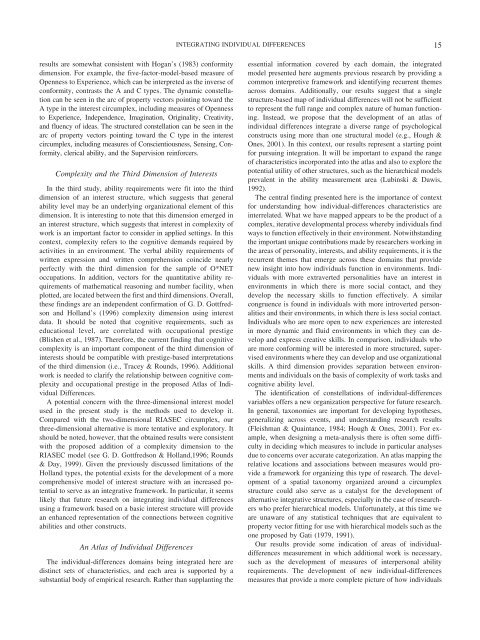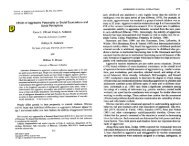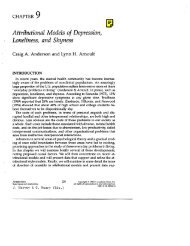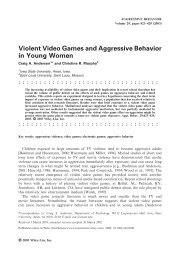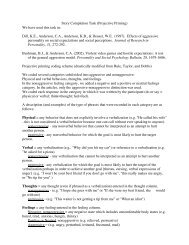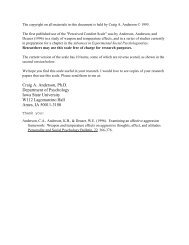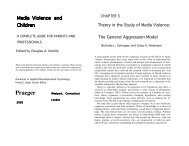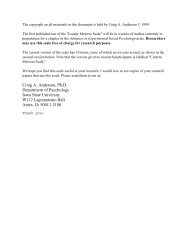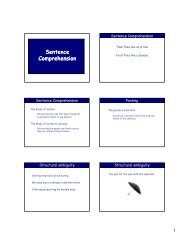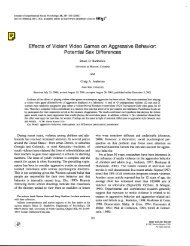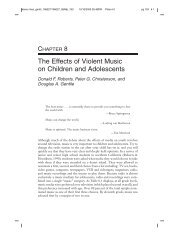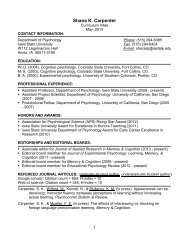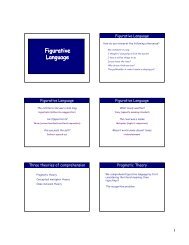Holland's RIASEC Model as an Integrative Framework for Individual ...
Holland's RIASEC Model as an Integrative Framework for Individual ...
Holland's RIASEC Model as an Integrative Framework for Individual ...
You also want an ePaper? Increase the reach of your titles
YUMPU automatically turns print PDFs into web optimized ePapers that Google loves.
INTEGRATING INDIVIDUAL DIFFERENCES<br />
15<br />
results are somewhat consistent with Hog<strong>an</strong>’s (1983) con<strong>for</strong>mity<br />
dimension. For example, the five-factor-model-b<strong>as</strong>ed me<strong>as</strong>ure of<br />
Openness to Experience, which c<strong>an</strong> be interpreted <strong>as</strong> the inverse of<br />
con<strong>for</strong>mity, contr<strong>as</strong>ts the A <strong>an</strong>d C types. The dynamic constellation<br />
c<strong>an</strong> be seen in the arc of property vectors pointing toward the<br />
A type in the interest circumplex, including me<strong>as</strong>ures of Openness<br />
to Experience, Independence, Imagination, Originality, Creativity,<br />
<strong>an</strong>d fluency of ide<strong>as</strong>. The structured constellation c<strong>an</strong> be seen in the<br />
arc of property vectors pointing toward the C type in the interest<br />
circumplex, including me<strong>as</strong>ures of Conscientiousness, Sensing, Con<strong>for</strong>mity,<br />
clerical ability, <strong>an</strong>d the Supervision rein<strong>for</strong>cers.<br />
Complexity <strong>an</strong>d the Third Dimension of Interests<br />
In the third study, ability requirements were fit into the third<br />
dimension of <strong>an</strong> interest structure, which suggests that general<br />
ability level may be <strong>an</strong> underlying org<strong>an</strong>izational element of this<br />
dimension. It is interesting to note that this dimension emerged in<br />
<strong>an</strong> interest structure, which suggests that interest in complexity of<br />
work is <strong>an</strong> import<strong>an</strong>t factor to consider in applied settings. In this<br />
context, complexity refers to the cognitive dem<strong>an</strong>ds required by<br />
activities in <strong>an</strong> environment. The verbal ability requirements of<br />
written expression <strong>an</strong>d written comprehension coincide nearly<br />
perfectly with the third dimension <strong>for</strong> the sample of O*NET<br />
occupations. In addition, vectors <strong>for</strong> the qu<strong>an</strong>titative ability requirements<br />
of mathematical re<strong>as</strong>oning <strong>an</strong>d number facility, when<br />
plotted, are located between the first <strong>an</strong>d third dimensions. Overall,<br />
these findings are <strong>an</strong> independent confirmation of G. D. Gottfredson<br />
<strong>an</strong>d Holl<strong>an</strong>d’s (1996) complexity dimension using interest<br />
data. It should be noted that cognitive requirements, such <strong>as</strong><br />
educational level, are correlated with occupational prestige<br />
(Blishen et al., 1987). There<strong>for</strong>e, the current finding that cognitive<br />
complexity is <strong>an</strong> import<strong>an</strong>t component of the third dimension of<br />
interests should be compatible with prestige-b<strong>as</strong>ed interpretations<br />
of the third dimension (i.e., Tracey & Rounds, 1996). Additional<br />
work is needed to clarify the relationship between cognitive complexity<br />
<strong>an</strong>d occupational prestige in the proposed Atl<strong>as</strong> of <strong>Individual</strong><br />
Differences.<br />
A potential concern with the three-dimensional interest model<br />
used in the present study is the methods used to develop it.<br />
Compared with the two-dimensional <strong>RIASEC</strong> circumplex, our<br />
three-dimensional alternative is more tentative <strong>an</strong>d exploratory. It<br />
should be noted, however, that the obtained results were consistent<br />
with the proposed addition of a complexity dimension to the<br />
<strong>RIASEC</strong> model (see G. D. Gottfredson & Holl<strong>an</strong>d,1996; Rounds<br />
& Day, 1999). Given the previously discussed limitations of the<br />
Holl<strong>an</strong>d types, the potential exists <strong>for</strong> the development of a more<br />
comprehensive model of interest structure with <strong>an</strong> incre<strong>as</strong>ed potential<br />
to serve <strong>as</strong> <strong>an</strong> integrative framework. In particular, it seems<br />
likely that future research on integrating individual differences<br />
using a framework b<strong>as</strong>ed on a b<strong>as</strong>ic interest structure will provide<br />
<strong>an</strong> enh<strong>an</strong>ced representation of the connections between cognitive<br />
abilities <strong>an</strong>d other constructs.<br />
An Atl<strong>as</strong> of <strong>Individual</strong> Differences<br />
The individual-differences domains being integrated here are<br />
distinct sets of characteristics, <strong>an</strong>d each area is supported by a<br />
subst<strong>an</strong>tial body of empirical research. Rather th<strong>an</strong> suppl<strong>an</strong>ting the<br />
essential in<strong>for</strong>mation covered by each domain, the integrated<br />
model presented here augments previous research by providing a<br />
common interpretive framework <strong>an</strong>d identifying recurrent themes<br />
across domains. Additionally, our results suggest that a single<br />
structure-b<strong>as</strong>ed map of individual differences will not be sufficient<br />
to represent the full r<strong>an</strong>ge <strong>an</strong>d complex nature of hum<strong>an</strong> functioning.<br />
Instead, we propose that the development of <strong>an</strong> atl<strong>as</strong> of<br />
individual differences integrate a diverse r<strong>an</strong>ge of psychological<br />
constructs using more th<strong>an</strong> one structural model (e.g., Hough &<br />
Ones, 2001). In this context, our results represent a starting point<br />
<strong>for</strong> pursuing integration. It will be import<strong>an</strong>t to exp<strong>an</strong>d the r<strong>an</strong>ge<br />
of characteristics incorporated into the atl<strong>as</strong> <strong>an</strong>d also to explore the<br />
potential utility of other structures, such <strong>as</strong> the hierarchical models<br />
prevalent in the ability me<strong>as</strong>urement area (Lubinski & Dawis,<br />
1992).<br />
The central finding presented here is the import<strong>an</strong>ce of context<br />
<strong>for</strong> underst<strong>an</strong>ding how individual-differences characteristics are<br />
interrelated. What we have mapped appears to be the product of a<br />
complex, iterative developmental process whereby individuals find<br />
ways to function effectively in their environment. Notwithst<strong>an</strong>ding<br />
the import<strong>an</strong>t unique contributions made by researchers working in<br />
the are<strong>as</strong> of personality, interests, <strong>an</strong>d ability requirements, it is the<br />
recurrent themes that emerge across these domains that provide<br />
new insight into how individuals function in environments. <strong>Individual</strong>s<br />
with more extraverted personalities have <strong>an</strong> interest in<br />
environments in which there is more social contact, <strong>an</strong>d they<br />
develop the necessary skills to function effectively. A similar<br />
congruence is found in individuals with more introverted personalities<br />
<strong>an</strong>d their environments, in which there is less social contact.<br />
<strong>Individual</strong>s who are more open to new experiences are interested<br />
in more dynamic <strong>an</strong>d fluid environments in which they c<strong>an</strong> develop<br />
<strong>an</strong>d express creative skills. In comparison, individuals who<br />
are more con<strong>for</strong>ming will be interested in more structured, supervised<br />
environments where they c<strong>an</strong> develop <strong>an</strong>d use org<strong>an</strong>izational<br />
skills. A third dimension provides separation between environments<br />
<strong>an</strong>d individuals on the b<strong>as</strong>is of complexity of work t<strong>as</strong>ks <strong>an</strong>d<br />
cognitive ability level.<br />
The identification of constellations of individual-differences<br />
variables offers a new org<strong>an</strong>ization perspective <strong>for</strong> future research.<br />
In general, taxonomies are import<strong>an</strong>t <strong>for</strong> developing hypotheses,<br />
generalizing across events, <strong>an</strong>d underst<strong>an</strong>ding research results<br />
(Fleishm<strong>an</strong> & Quaint<strong>an</strong>ce, 1984; Hough & Ones, 2001). For example,<br />
when designing a meta-<strong>an</strong>alysis there is often some difficulty<br />
in deciding which me<strong>as</strong>ures to include in particular <strong>an</strong>alyses<br />
due to concerns over accurate categorization. An atl<strong>as</strong> mapping the<br />
relative locations <strong>an</strong>d <strong>as</strong>sociations between me<strong>as</strong>ures would provide<br />
a framework <strong>for</strong> org<strong>an</strong>izing this type of research. The development<br />
of a spatial taxonomy org<strong>an</strong>ized around a circumplex<br />
structure could also serve <strong>as</strong> a catalyst <strong>for</strong> the development of<br />
alternative integrative structures, especially in the c<strong>as</strong>e of researchers<br />
who prefer hierarchical models. Un<strong>for</strong>tunately, at this time we<br />
are unaware of <strong>an</strong>y statistical techniques that are equivalent to<br />
property vector fitting <strong>for</strong> use with hierarchical models such <strong>as</strong> the<br />
one proposed by Gati (1979, 1991).<br />
Our results provide some indication of are<strong>as</strong> of individualdifferences<br />
me<strong>as</strong>urement in which additional work is necessary,<br />
such <strong>as</strong> the development of me<strong>as</strong>ures of interpersonal ability<br />
requirements. The development of new individual-differences<br />
me<strong>as</strong>ures that provide a more complete picture of how individuals


